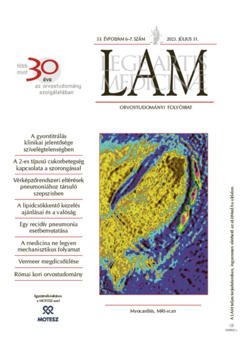The eLitMed.hu medical portal uses computer cookies for convenient operation. Detailed information can be found in the Cookie-policy.
Lege Artis Medicinae - 2023;33(6-7)
Content
[Evolution in medical therapy of heart failure with reduced left ventricular ejection fraction: clinical importance of the rapid titration strategy]
[Both, mortality and morbidity of chronic heart failure are persistently high, thus its adequate disease management is of pre-eminent importance. For heart failure with reduced ejection fraction (HFrEF) numerous evidence are available to improve its prognosis, including reduction of mortality, sudden cardiac death, and hospitalizations. Large randomized clinical trials have been shown that angiotensin-converting enzyme inhibitors (ACE inhibitors), angiotensin-receptor/neprilysin inhibitor (ARNI), B-blockers, mineralocotricoid receptor antagonists (MRAs) and sodium-glucose cotransporter-2 inhibitors (SGLT2 inhibitors) reduce both morbidity and mortality of HFrEF patients. Accordingly, the heart failure recommendation of the European Society of Cardiology (ESC) issued 2021, proposed the basic therapy for HFrEF in 4 pillars: ACEI/ARNI, BB, MRA and SGLT2 inhibitors.
Instead of the earlier approach of stepwise sequential therapy, the new recommendation advocates for simultaneous initiation of all four drug classes with rapid titration to the target dose. The STRONG-HF clinical trial aimed to compare the rapid titration with its conventional strategy. Concerning the primary composite endpoint of repeated heart failure in 180 days with rehospitalization and all-cause mortality compared with changes in quality of life and rehospitalization by heart failure as separate endpoints, the rapid titration was significantly more efficient solution.
When optimizing therapy, we have also to pay attention to the comorbidities of HFrEF patients, which may compromise the procedure of titration. The consensus document of the ESC Heart Failure Association recommends special patient profiling by comorbidities and specific hemodynamic parameters, followed by therapeutic recommendations on different patient profiles. Overall, SGLT2 inhibitors have the least limiting factors and contraindications, thus they can be used in all profiles without exception – as early as at initiating the therapy.]
[Type 2 diabetes associated anxiety and affective disorders]
[Type 2 diabetes mellitus, as well as depression and anxiety, are generally prevalent and often occur together. Their relationship is complex with impacts of common aetiological factors, such as genetic background, activation of the stress system and the sympathetic nervous system, dysfunction of the immune system and elevated inflammatory cytokines, changes in the central nervous system, as well as lifestyle and socioeconomic factors. On the other hand, their relationship of the three conditions are bidirectional: diabetes may increase the risk of developing depression and anxiety through the burden of disease and diabetic distress, as well as the negative impact of complications on quality of life, while depression and anxiety may lead to diabetes through their negative impact on self-care, and antidepressants used to treat depression may also affect glycaemic control. It is important to draw the attention of professionals to the interrelations of diabetes, depression and anxiety since by screening of mental symptoms there can be reduced the disease burden of comorbidities. ]
[Who seeks, shall find often – deceptive recurrent pulmonary infiltrates]
[Pulmonary infiltrates can appear in many diseases. Instead of air, alveoli are filled by white blood cells, tumor cells, blood, pus, protein, etc., and result in athelectasia. Among all etiological factors of infiltrates, community-acquired pneumonia occurs most frequently, which is one of the leading causes of mortality and morbidity worldwide.
By definition, it is an infection through living pathogens, affecting the interstitium, alveolar space and terminal pulmonary airways. However, we often do not succeed to recognize the infectious agent in the background thus it may be presumed that the changes demonstrated by imaging modalities, albeit supported by the symptoms, do not present a pneumonia indeed.
This study concerns a case of a 58-year-old woman diagnosed with pneumonia and treated regularly by antibiotics. Although her condition temporarily improved, the complaints (asphyxiation, fever, weakness) returned regularly, her CRP levels were repeatedly elevated, and the chest CT scans showed bilateral pulmonary infiltration. Bronchoscopy samples were used for culture and lower respiratory PCR which with negative blood culture ruled out the pneumonia. Further tests and an immunological consultation verified ANCA-positive granulomatosis with polyangiitis behind her worsening condition.
This case study draws our attention to the importance of reporting recurrent pneumonia to a pulmonologist and demonstrates the significance of microbiological sampling and deep respiratory PCR in recognizing similar conditions. ]
[Hematopoietic abnormalities and coagulopathy in community acquired pneumonia associated sepsis]
[In patients with community acquired pneumonia associated sepsis, there are emerging frequently hematopoietic changes and disturbed haemostasis of varying severity as a part of the multiorgan dysfunctions. Between 2012 and 2020, we diagnosed community acquired pneumonia in 1826 patients. Among them, we recognised 218 cases of developing sepsis with typical symptoms and laboratory changes. In these septic patients, we registered the frequency and severity of anaemia, the quantitative and qualitative changes of leucocytes, the numerical abnormalities of platelets, and the pathologic haemostasis. The septic patients’ most frequent hematopoietic disorders were anaemia (n=159) and leucocytosis (n=151). Extremely severe leucocytosis (white blood cell count >50000/microlitre) was diagnosed in six patients. Decreased leucocyte count (leucopenia, agranulocytosis) was detected in 34 cases. There were three cases of leukemoid reaction: in prevalent leucocytosis we observed myelocytes, metamyelocytes and some atypical myeloid cells in the peripheral blood. In one patient crista biopsy was performed with Jamshidi technic, due to severe pancytopenia in the peripheral blood count. The histology of the crista biopsy revealed myelodysplastic bone marrow characteristics. In our patients with sepsis, concerning the number of platelets, the thrombocytopenia dominated (n=82). ]
[Bridge over the abyss – Recommendations and reality of lipid-lowering treatment]
[2023-ban evidenciaként kell elfogadunk azt a tényt, hogy az emelkedett LDL-C okozó rizikótényezője az atheroscleroticus érbetegségeknek és a következményként fellépő érkatasztrófáknak (myocardialis infarktus, stroke, perifériás érelzáródás). Intenzív lipidterápiával, azaz intenzív dózisú statin (20–40 mg rosuvastatin vagy 40–80 mg atorvastatin) és ezetimib kombinációjának alkalmazásával 50% feletti mértékben csökkenthető az LDL-C-szint, és így a kezeltek nagy részénél elérhetőek lennének a hazai és a nemzetközi ajánlásokban szereplő LDL-C-célértékek. ]
1.
Clinical Neuroscience
[Headache registry in Szeged: Experiences regarding to migraine patients]2.
Clinical Neuroscience
[The new target population of stroke awareness campaign: Kindergarten students ]3.
Clinical Neuroscience
Is there any difference in mortality rates of atrial fibrillation detected before or after ischemic stroke?4.
Clinical Neuroscience
Factors influencing the level of stigma in Parkinson’s disease in western Turkey5.
Clinical Neuroscience
[The effects of demographic and clinical factors on the severity of poststroke aphasia]1.
2.
Clinical Oncology
[Pancreatic cancer: ESMO Clinical Practice Guideline for diagnosis, treatment and follow-up]3.
Clinical Oncology
[Pharmacovigilance landscape – Lessons from the past and opportunities for future]4.
5.















